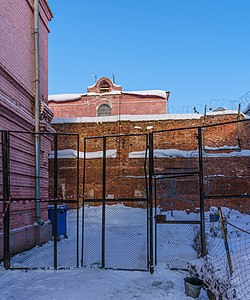Vladimir Central Prison: Difference between revisions
Epicurus BE (talk | contribs) No edit summary |
Epicurus BE (talk | contribs) mNo edit summary |
||
| Line 43: | Line 43: | ||
| page = 267 |
| page = 267 |
||
}}</ref> |
}}</ref> |
||
* [[Aleksei Navalny]], Russian opposition politician <ref>{{cite web|url=https://www.bloomberg.com/news/articles/2021-02-28/russia-sends-navalny-to-notorious-penal-camp-feared-by-inmates |
* [[Aleksei Navalny]], Russian opposition politician <ref>{{cite web|url=https://www.bloomberg.com/news/articles/2021-02-28/russia-sends-navalny-to-notorious-penal-camp-feared-by-inmates|title=Navalny sent to penal camp|access-date=28 February 2021}}</ref> |
||
* [[Garegin Nzhdeh]], [[Armenia]]n general and [[Dashnak]] revolutionary activist. |
* [[Garegin Nzhdeh]], [[Armenia]]n general and [[Dashnak]] revolutionary activist. |
||
* [[Francis Gary Powers]], [[United States|American]] pilot, shot down in a [[U2 spy plane]] on 1 May 1960, imprisoned here until February 1962. |
* [[Francis Gary Powers]], [[United States|American]] pilot, shot down in a [[U2 spy plane]] on 1 May 1960, imprisoned here until February 1962. |
||
Revision as of 16:35, 28 February 2021
 | |
 | |
| Location | Vladimir, Russia |
|---|---|
| Capacity | 1220 |
| Opened | 1783 |
| Managed by | Federal Penitentiary Service |
| Governor | Alexei Nikolaevich Klimov |

Vladimir Prison, popularly known as Vladimir Central (Russian: Владимирский централ), is a prison in Vladimir, Russia. It is the largest prison in Russia, with a capacity of 1220 detainees, and is operated by the Federal Penitentiary Service as a maximum-security prison with most inmates serving a minimum of ten years to life sentences.[1][2]
History

Vladimir Prison was established by the Russian Empire in 1783 by decree of Empress Catherine II, located about 160 kilometres (100 mi) northeast of Moscow. In 1906, it became known as Vladimir Central and contained political prisoners. At the beginning of 1921, shortly after the rise of the Bolsheviks to power, Vladimir Central became the first of several special-purpose prisons intended to house far-left opponents of the regime. Vladimir Central was later part of the system of "special camps and prisons" organized on the basis of the USSR Council of Ministers resolution No. 416-159 of February 21, 1948 "On the organization of the Ministry of Internal Affairs camps with a strict regime for keeping particularly dangerous state criminals". The resolution widened the range of political prisoners for the detention in Vladimir, including spies, saboteurs, terrorists, Trotskyites, Mensheviks, Socialist-Revolutionaries, anarchists, ethnic nationalists, white émigrés, participants in other anti-Soviet organizations, and those with ties to any anti-Soviet or enemy activities. In service documents, the name of the prison was listed as "Vladimir special prison MGB of the USSR." After the dissolution of the Soviet Union, the prison was reverted to a regular detention facility. In 1996, a museum about Vladimir Prison was opened on the prison grounds.
Vladimir Prison is currently the largest prison by capacity in Russia, with a capacity for a maximum of 1220 detainees, however it is set to be surpassed by Kresty 2 currently under construction in Kolpino, Saint Petersburg.
Popular culture
Vladimir Prison is the subject of the songs "Jewish Prisoner" and "Vladimir Central" by the singer-songwriter Mikhail Krug.
Notable inmates
- Vasily Dzhugashvili, son of Joseph Stalin.
- Jan Stanisław Jankowski, Polish politician.
- Paul Ludwig Ewald von Kleist, German field marshal.
- Johan Laidoner, Estonian commander-in-chief of the Estonian Army.
- Yosef Mendelevitch, Jewish Refusenik dissident.[3]
- Aleksei Navalny, Russian opposition politician [4]
- Garegin Nzhdeh, Armenian general and Dashnak revolutionary activist.
- Francis Gary Powers, American pilot, shot down in a U2 spy plane on 1 May 1960, imprisoned here until February 1962.
- Mečislovas Reinys, Lithuanian Roman Catholic bishop.
- Natan Sharansky, Jewish Refusenik dissident.
- Klymentiy Sheptytsky, archimandrite of the Russian Greek Catholic Church.
- Serhiy Yefremov, Ukrainian socialist federalist.
- Dušan Letica, Serbian fascist politician.
- Stepan Maximovich Petrichenko, Russian Anarchist, head of the Kronstadt Rebellion
- Andras Toma, a Hungarian soldier taken prisoner by the Red Army in 1945, and remained in detention until 2000.
References
- ^ "Article". Time Magazine. 3 January 1977. Retrieved 10 November 2010.
- ^ "Reset Delegation Visits Vladimir Prison". Retrieved 10 November 2010.
- ^ Mendelevich, Yosef (2012). Unbroken Spirit. Gefen Publishing House. p. 267. ISBN 978-965-229-563-7.
- ^ "Navalny sent to penal camp". Retrieved 28 February 2021.
56°08′30″N 40°25′58″E / 56.141545°N 40.432662°E
